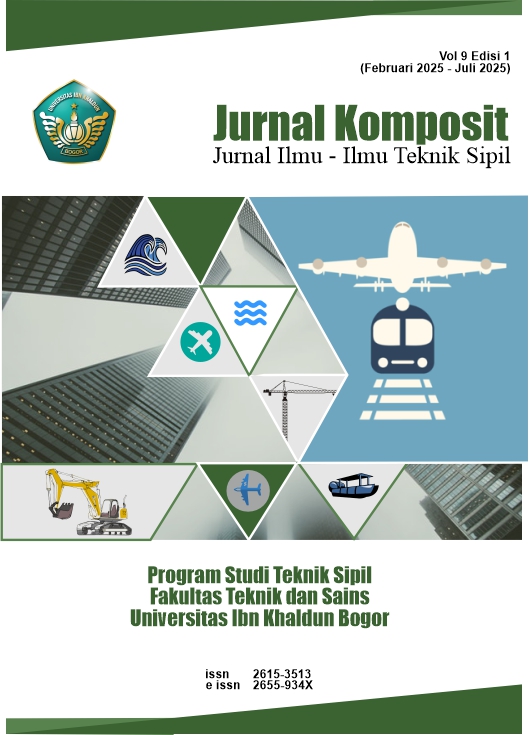Perencanaan Perkerasan Jalan dengan Metode Manual Desain Perkerasan (MDP) (Studi Kasus: Jalan Poncowati – Purnama Tunggal Kabupaten Lampung Tengah)
DOI:
https://doi.org/10.32832/komposit.v9i1.16388Keywords:
Pavement Planning, Pavement Design Manual (MDP) 2017, flexible pavement (Flexible Pavement)Abstract
Increasing population leads to increased access needs roads as a means to move from a place. It takes a path feasible so that there are no obstacles that occur, it is expected to do road planning using pavement design Manual method (MDP) 2017 to get a design that is in accordance with its designation. This research done with the aim of knowing the existing condition of the road and determine design optimal pavement planning to fit the existing conditions on the road Poncowati-Purnama Tunggal Lampung Tengah Regency because on the road there are many public facilities needed people and road conditions are quite damaged. Research methods by means of calculate the volume of vehicle traffic and require primary data in the form of survey results of existing road conditions, and soil bearing capacity by using (Dynamic Cone Penetrometer) DCP. Secondary Data used is data (Average daily traffic) LHR. The results obtained carrying capacity conditions the soil is quite good with the smallest CBR results of 20.03 so it does not need improvement of subgrade condition on Poncowati-Purnama Tunggal road. Road conditions have been damaged and need to be repaired by using flexible pavement based on ESA calculation results Rank 4 and pavement design selection table in pavement design Manual (MDP) 2017, with the thickness of the upper foundation layer (LFA) 400 mm, Asphaltic Concrete Binder Course (AC-BC) 60 mm, and asphalt Concrete Wearing Course (AC-WC) 40 mm based on the calculation of ESA Power 5 and using reference to the design table in the pavement design Manual (MDP) 2017. There is a repair of total damage (reconstruction). Budget plan (RAB) wich estimate at Rp.9.291.416.000,-
References
Arthono, A., & Pransiska, D. A. (2022). Perencanaan Perkerasan Lentur Jalan Raya Menggunakan Metode SNI 1932-1989-F Dibandingkan dengan Menggunakan Metode AASTHO 1993, pada Ruas Jalan Raya Rangkasbitung-Citeras. Prosiding Semnastek. https://jurnal.umj.ac.id/index.php/semnastek/article/view/14671
Bamher, B. G. (2020). Analisis Tebal Perkerasan Lentur Menggunakan Metode Manual Desain Perkerasan Jalan 2017 pada Proyek Jalan Baru Batas Kota Singaraja-Mengwitani, Buleleng (Doctoral dissertation, Universitas Atma Jaya Yogyakarta). http://e-journal.uajy.ac.id/id/eprint/23107
Departemen Pekerjaan Umum, 2010. Direktorat Jendral Bina Marga, (2017). Manual Desain Perkerasan Jalan (MDP), Nomor. 02/M/BM/2017.Jakarta. https://binamarga.pu.go.id/uploads/files/1737/02mbm2017-manual-desain-perkerasan-jalan.pdf
Hardiyatmo. (2015). Perancangan Perkerasan Jalan dan Penyelidikan Tanah, Yogyakarta, Gadjah Mada University. https://ugmpress.ugm.ac.id/en/product/teknik-sipil/perancangan-perkerasan-jalan-dan-penyelidikan-tanah-edisi-ke-3
Hidayatulloh, C., & Ariostar, A. (2022). Perencanaan Geometrik dan Perkerasan Lentur Jalan Raya (Studi Kasus: Ruas Jalan Tarutung - Bts. Kabupaten Tapanuli Selatan). Jurnal Komposit: Jurnal Ilmu-Ilmu Teknik Sipil, 5(2), 75–85. https://doi.org/10.32832/komposit.v5i2.628
Indera, E. (2022). Desain Tebal Perkerasan Lentur (Flexible Pavement) Jalan Sawah Indah –Tande Daek Lingga - Kabupaten Lingga. Sigma Teknika, 5(2), 383-397. DOI: https://doi.org/10.33373/sigmateknika.v5i2.4670
Irsan, E. T. (2023). Perencanaan Perkerasan Flexible Pada Perkerasan Jalan Dengan Menggunakan Metode Bina Marga 2017 (Doctoral dissertation, Universitas Medan Area). https://repositori.uma.ac.id/handle/123456789/20159
Kementrian Pekerjaan Umum (2010). Surat Edaran Menteri Pekerjaan Umum Nomor. 04/SE/M/2010 tentang Pemberlakuan Pedoman Cara Uji California Bearing Ratio (CBR) dengan Dynamic Cone Penetrometer (DCP). Jakarta. file:///C:/Users/MyBook%20Hype%20AMD/Downloads/pedoman-cara-uji-cbr-dengan-dynamic-cone-penetrom
Kholiq, A. (2014). Perencanaan Tebal Perkerasan Lentur Jalan Raya Antara Bina Marga Dan AASHTO’93 (Studi Kasus: Jalan Lingkar Utara Panyingkiran-Baribis Majalengka). J-Ensitec, 1(01). DOI: http://dx.doi.org/10.31949/j-ensitec.v1i01.15
Mamari, R. L. P. (2017). Studi Perencanaan Perkerasan Lentur Jalan Raya Dengan Standar Bina Marga Pada Ruas Jalan Sentani-Warumbain Km 41+ 000-Km 61+ 000 (20 Km) (Doctoral dissertation, ITN Malang). http://eprints.itn.ac.id/id/eprint/1928
Novanto, G. W. K. (2023). Analisis Kinerja Vissim (Studi Kasus: Persimpangan Bersinyal Jalan Pagar Alam Bandar Lampung). Jurnal Sipil Sains, 13(1). DOI: https://doi.org/10.33387/sipilsains.v13i1.5834
Oetomo, W. (2013). Alternatif Lain Analisis Struktur Jalan Perkerasan Lentur pada Pembangunan Jalan Lingkar Selatan Kota Pasuruan. Ekstrapolasi Jurnal Teknik Sipil UNTAG Surabaya. Surabaya, 6(01), 118-136. https://scholar.google.co.id/citations?user=qamEdt8AAAAJ&hl=id
Sirait, F. O. S., & Elvina, I. (2020). Tebal Perkerasan Lentur (Flexible Pavement) Menggunakan Metode Manual Desain Perkerasan Tahun 2017. Jurnal Teknika: Jurnal Teoritis dan Terapan Bidang Keteknikan, 3(2), 186-197. DOI: https://doi.org/10.52868/jt.v3i2.2639
Sudarno, S., Falakh, A. N., & Navitasari, N. D. (2018). Evaluasi Tebal Perkerasan Jalan Raya Secang-Magelang Menggunakan Metode Analisa Komponen. Jurnal Disprotek, 9(2), 97-101.
DOI: https://doi.org/10.34001/jdpt.v9i2.803
Sumarsono, S., & Gultom, H. J. H. (2018). Perbandingan Analisa Perkerasan Metode Bina Marga Revisi Juni 2017 dan AASHTO 1993 (Studi Kasus pada Pekerjaan Rencana Preservasi Ruas Jalan Jatibarang-Langut TA 2017). RekaRacana: Jurnal Teknil Sipil, 4(3), 60. DOI: https://doi.org/10.26760/rekaracana.v4i3.60
Sukirman, S. (2010). Perkerasan Lentur Jalan Raya, Penerbit Nova, Bandung. https://onesearch.id/Author/Home?author=Sukirman%2C+Silvia
Downloads
Published
How to Cite
Issue
Section
License
Copyright (c) 2025 Jurnal Komposit: Jurnal Ilmu-ilmu Teknik Sipil

This work is licensed under a Creative Commons Attribution-NonCommercial-ShareAlike 4.0 International License.
Authors who publish with this journal agree to the following terms (Penulis yang mengajukan publikasi artikel telah menyetujui hal berikut):
- Through this publication, the author agree to submit the copyright of article writing to Jurnal Komposit: Jurnal Ilmu-ilmu Teknik Sipil. This copyright submission takes the form of, but is not limited to: reproduction of the article and parts therein, including photographic reproductions; distribution of articles through printed and electronic documents; and translation of articles(Bahwa melalui publikasi ini, hak cipta penulisan artikel diserahkan kepada Jurnal Komposit: Jurnal Ilmu-ilmu Teknik Sipil. Penyerahan hak cipta ini berupa, namun tidak terbatas pada: perbanyakan artikel dan bagian di dalamnya, termasuk reproduksi fotografi; penyebarluasan artikel melalui dokumen cetak dan elektronik; serta penterjemahan artikel).
- The authors agree to the terms of the Copyright Notice, according to Creative Commons Attribution-NonCommercial-ShareAlike 4.0 International License., which will apply to this article if and when it is published by Jurnal Komposit: Jurnal Ilmu-ilmu Teknik Sipil. (Para penulis setuju dengan ketentuan Pemberitahuan Hak Cipta, sesuai dengan Lisensi Internasional Creative Commons Attribution-NonCommercial-ShareAlike 4.0., yang akan berlaku untuk artikel ini jika dan ketika diterbitkan oleh Jurnal Komposit: Jurnal Ilmu-ilmu Teknik Sipil).

This work is licensed under a Creative Commons Attribution-NonCommercial-ShareAlike 4.0 International License.



.png)










